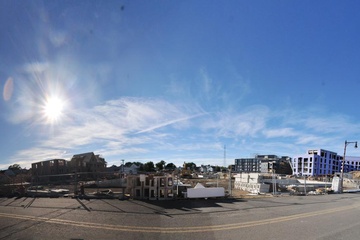One year after we watched Al Gore ’69 extol the virtues of sustainability to the Harvard community, hot cider and apple pie clutched in our palms, the flags in the yard are taken down, the free t-shirts are shoved in the bottom of our dressers, and you might be wondering: is green still the new Crimson?Thanks to the Office For Sustainability (OFS), the undergraduate Resource Efficiency Program (REP), and the cooperation of the University and students, it is. The flags and t-shirts may be gone, but the blue recycling bins remain stacked in every dorm, and it’s hard to find a toilet on campus without a bright green dual-flush handle. Beyond these colors shouting at you to live a “greener” life, though, the biggest contributors to sustainability aren’t necessarily our personal efforts, but instead the buildings we live and work in. The big push this year is green building, and with the 20th Leadership in Energy and Environmental Design (LEED) certification of a Harvard facility, we’re well on our way to a greener university.Harvard’s current LEED projects represent upwards of 1,000,000 square feet of space and savings of $680,000 and 1,500 metric tons of carbon dioxide per year. Harvard’s 20 LEED certifications take the win for any institution of higher education—more than the rest of the Ivy League combined and, for you fans of rivalry, three times more certifications than Yale.“Green building is important because Harvard’s more than 700 existing buildings contribute the bulk of our emissions today,” says Heather A. Henriksen, Director of OFS. “And new buildings will add new emissions, no matter how efficient they are,” .To be LEED-certified, buildings must be environmentally friendly in terms of sustainable sites, water efficiency, energy performance, materials, and indoor environmental quality. While all new buildings and renovations planned at Harvard will follow LEED guidelines, it would be impossible to tear down the buildings in Harvard Yard, which is protected as a historic district, in the name of the environment. Instead, the OFS works with buildings in the Yard and the Houses from the inside.“Despite the challenges of working with existing historic buildings, we have been able to achieve success in energy conservation while preserving both the embodied energy in the existing structure and the historic face of Harvard and Cambridge,” writes Nathan Gauthier, an Assistant Director of OFS, in an e-mail to The Crimson. As a result, Harvard won the Charles W. Eliot Award for organizations with exceptional vision and excellence in planning. Harvard is currently waiting for the U.S. Green Building Council to confirm 139-year-old Thayer Hall as its first LEED-certified dorm. However, the freshmen of Thayer will also be the last dorm residents to receive a plaque in the near future.“We are not going to pursue LEED-EB (the certification intended for existing buildings) for the rest of the dorms at this time,” says Jay M. Phillips, Director of Energy, Sustainability and Infrastructure in the Faculty of Arts and Sciences’ Office of Physical Resources. “Instead, we will take the best practices from the LEED process and apply them to the other dorms without going for the formal certification.”According to Anthony Pacillo, Senior Manager of Harvard Yard and Freshman Dormitories, increasing sustainability in the dorms is a complex process which includes installing dual-flush toilets, motion sensor lighting, water-saving showerheads, and increased recycling. As Pacillo says, it’s an effort to do “basically whatever we can possibly do in the buildings.”Despite budget cuts this year, OFS is still aggressively pursuing green building. Gauthier conservatively estimates at least ten more plaques by the time the class of 2010 graduates; most of these certifications will result from renovations rather than new buildings.To help with meet this challenge, OFS has enlisted the help of students in each house and dorm through REP for efforts on an individual level. “REP Reps” work to spread environmental awareness and encourage recycling, double-sided printing, and reducing waste on a day-to-day basis. Rachel H. Mak ’10, a student captain of REP, applauded the college for getting rid of the printed CUE Guide and emphasized other contributions that students can make just by reducing waste. “Right now Harvard has a recycling rate of 55%, and that’s pretty good,” she says. “But we could definitely work to increase that and educate students on what is recyclable and what isn’t.”While we can’t all be as effortly sustainable as Thayerites, FAS, which includes the College, can be proud to claim the most LEED projects of any of Harvard’s schools, with one certification and 26 registered buildings. Moreover, there are additional smaller projects such as the nation’s first LEED-certified kitchen in Dunster and Mather. You may not be standing in an official “green” building yet, but chances are that at least part of it has reduced Harvard’s environmental footprint.


